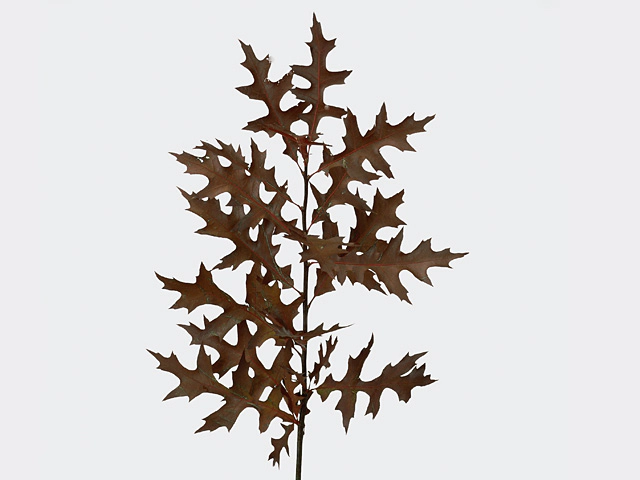Quercus palustris per bunch

| Genus | Monoecious |
| Height | 10 - 20 m |
| Life span | Long (over 200 years) |
| Shape of tree | Conic |
| Leaf margin | Dentate |
| Flower scent | Unscented |
| Leaf type | Foliage leaf |
| Winter hardness | Good (USDA-zone 5, 6) |
| Flower color | Yellow; White |
| Fruit color | Brown |
| Soil fertility | Not very demanding |
| Plant height | 10 - 20 m |
| Inflorescence | Catkin |
| Flowering month(s) | April |
| Leaf color | Green |
| Fruit size | Small |
| Leaf duration | Deciduous |
| Light conditions | Sunny |
| Growth rate | Normal; Fast |
| Leaf division | Simple |
| Leaf, main color | Dark green |
| Sensibilité au sel d'épandage | Tolerant |
| Fruit color (notable) | Green |
| Autumn color (notable) | Red |
| Toxicity (if consumed) | Not or barely |
| Moisture requirements | Dry |
Quercus palustris, commonly known as the Pin Oak or Red Oak, is a magnificent tree that belongs to the genus Quercus. It is a monoecious species, meaning it has both male and female reproductive organs in separate flowers on the same tree. With a height ranging from 10 to 20 meters, this long-lived tree can survive for over 200 years, making it a symbol of strength and endurance.
The Pin Oak boasts a conical shape, with dentate (toothed) leaf margins. Its leaves are an attractive shade of green and have a simple division. During the autumn season, these leaves turn a stunning red color, adding a touch of vibrancy to any landscape.
In April, the Pin Oak displays its flowers in the form of catkins. The flowers have an unscented yellow or white color, which adds a subtle beauty to the tree. Following the flowering period, the Pin Oak produces small brown fruits, notable for their green color before ripening.
When it comes to its preferred growing conditions, the Pin Oak is relatively undemanding. It can adapt to a wide range of soil fertility levels and is generally tolerant of dry conditions. This makes it a suitable choice for gardens or landscapes where the soil might not be particularly fertile or where the moisture levels are lower.
The Pin Oak thrives in sunny areas and possesses good winter hardiness, suiting USDA zones 5 and 6. It has a normal to fast growth rate, allowing it to establish itself relatively quickly once planted. Additionally, this species demonstrates a decent tolerance to the salt often used for road de-icing, making it suitable for urban environments as well.
One of the standout features of the Pin Oak is its longevity. With a lifespan of over 200 years, this tree becomes a lasting presence in any setting, providing shade and natural beauty for generations to come. Its hardy nature and adaptability make it an excellent choice for those looking to plant a resilient and visually appealing tree.
While the Pin Oak is generally non-toxic, caution should still be exercised when considering its consumption. It is always best to consult a professional before using any part of the tree for medicinal or culinary purposes.
Overall, the Pin Oak, or Quercus palustris, is a remarkable tree with numerous desirable characteristics. From its striking red autumn foliage to its adaptability and longevity, this tree is a favorite among landscape enthusiasts and nature lovers alike. Whether planted as a standalone specimen or as part of a larger forest, the Pin Oak brings natural beauty and a touch of elegance wherever it is grown.
Market availability index by month:
| Jan. | Feb. | Mar. | Apr. | May | Jun. | Jul. | Aug. | Sep. | Oct. | Nov. | Dec. |
|---|---|---|---|---|---|---|---|---|---|---|---|
| 4 | 4 | 3 | 3 | 4 | 3 | 3 | 3 | 3 | 3 | 3 | 3 |